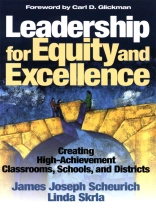’It brings into focus the many aspects of equity and equality in one source. It makes an excellent base for some meaningful discussion of these issues by those working with aspiring educator leaders, as well as those already in the field.’
Deborah A. Drugan, Principal
General John J. Stefanik Elementary School, Chicopee, MA
When true equity prevails, all students can be successful students!
Do you dream of success for every student? Do you dream of raising achievement for each and every child to meet the requirements of the No Child Left Behind Act? Historically, underserved students—children of color, children from low-income families, English language learners—all deserve to live this dream. Creating an equitable learning environment in which all students thrive is possible—with this guide you can turn dreams into reality for your school.
Leadership for Equity and Excellence encourages school leaders and teachers to develop creative strategies for student advancement using tools such as accountability, equity audits, and proactive redundancy. Scheurich and Skrla demonstrate how deeply held beliefs manifest as biases, preventing educators from unlocking their students′ potential. The authors also examine the U.S. education achievement gap, and suggest several concepts for overcoming this gap, such as:
- Eliminating ’can′t’ from your vocabulary
- Using creativity, perseverance, and persistence
- Envisioning educators as civil rights workers
- Moving beyond harmful, but entrenched, biases
- Understanding the cultures and backgrounds of each student
Children of color excelling in school . . . children from low-income homes thriving academically . . . classrooms, communities, and even a nation of people becoming truly equal—this is the living dream of today′s educators.
Innehållsförteckning
Foreword – Carl D. Glickman
Acknowledgments
About the Authors
1. Working on the Dream
What We Will Cover in the Book
2. Learning To Believe the Dream Is Possible
Barriers to Believing
Learning to Believe
Conclusion
3. Standards and Curriculum
Why Use Standards?
The Necessity of Curriculum Alignment
How Allignment of Standards and Curriculum Works in Creating Equitable and Excellent Schools
Conclusion
4. Instruction and Classroom Climate
High Expectations and Respect
Culturally Responsive Teaching
Loving and Caring in the Classroom
Democratic, Collaborative Teaching Environments
Continual Development of Content Expertise
Discipline Problems Are Largely a Function of Inequity, a Lack of Caring, and Weak Instruction
Conclusion
5. Accountability and Appropriate Data Usage
Avoiding the Test Factory Response to Accountability
Using Accountability Positively for Equitable and Excellent Schooling
Conclusion
6. Using Data to Uncover and Erase Systemic Inequities
Applying Equity Audits to Gifted and Talented Program Data
Using Equity Audits on Special Education Data
Using Equity Audits on Discipline
A Process for Addressing Inequities Identified by Equity Audits
Using Equity Audits on Achievement Data and Teacher Quality Data
Conclusion
7. School Leadership and Continuous Improvement
Three Essential Characteristics of Leadership for Equity and Excellence
Sustaining Yourself as a Leader for Equity and Excellence
A Note for Campus and District Leaders on Building Leadership Capacity
A Note to Principals and District Leaders About Assistant Principals
Conclusion
8. Proactive Redundancy
Proactive Redundancy in the Classroom
Proactive Redundancy in Teacher Professional Development
Proactive Redundancy Involving District Support Staff
The Importance of Proactive Redundancy in Equitable and Excellent Schools
Conclusion
9. Deep Collaboration with Parents and Community
Conclusion
10. The Final Call: Working on the Dream Each Day in Every Way
What We See in the Future
Final Words, the Final Call
References
Index
Om författaren
Linda Skrla is Professor of Educational Administration at Texas A&M University. Prior to joining the Texas A&M faculty in 1997, Linda worked as a middle school and high school teacher and as a campus and district administrator in public schools. Her research focuses on educational equity issues in school leadership, including accountability policy, high success school districts, and women superintendents. Linda is Vice President of Division A of the American Educational Research Association (AERA) and Editor of Educational Administration Quarterly. She has published extensively in academic journals and has co-authored and co-edited five other books, the most recent of which is Using Equity Audits to Create Equitable and Excellent Schools (Corwin Press, 2009).












